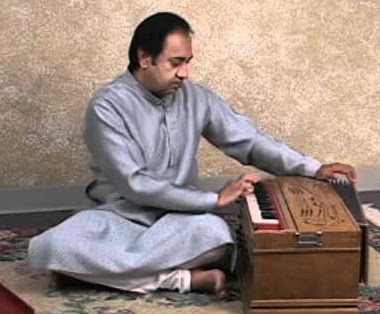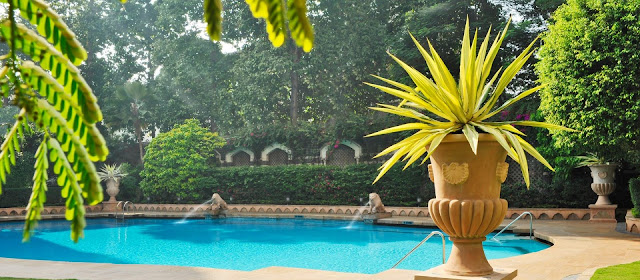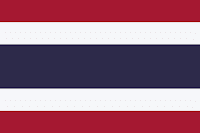* * * * *
As for the terminal, it was old, tired and badly in need of renovation.
In spite of this, Bombay Airport did have
some amusing episodes.
On
one layover, we were assigned Gate 47, at Terminal 2, which required us to use
taxiway “G” – a taxiway I hadn’t used before.
It was the captain’s leg – meaning it was his turn to taxi the 747 – and
my turn to run the radio, check the airport layout chart, and keep a sharp
lookout for obstacles. In so doing, I immediately
noticed how unusually narrow this taxiway was.
Plus, from my right seat thirty feet above the ground, I spotted a perpendicular
wall ahead, running up to and stopping well short of our taxiway. Engine number three looked okay for clearance,
but engine number four was going to pass directly over the end of this concrete
block wall. From where I sat, well above
the engine and wall, it appeared to be a tight fit.
As
the cockpit passed abeam of the wall, I craned my neck to keep track of engine
four’s approach. Remember, dear reader,
the 747 has swept wings – placing the engines well behind the cockpit.
Despite
my diligence I became distracted, as the other side of the wall came into view,
by an Indian airport security guard in khaki uniform and beret. He had leaned his British Enfield rifle
against the wall – dropped his trousers to his ankles – and was squatting on
his haunches taking a dump. He looked up
at me – I looked down at him – and he threw me a perfect British soldier’s salute
as he continued to defecate. I sat there
a moment utterly stunned.
Welcome to Bombay, dear reader!
Oh
shit! What about engine four? Too late!
When I recovered from shock and glanced back at four, the engine was
already sliding across the wall.
Fortunately for me it wasn’t dislodging any concrete blocks. Even so, it must have deafened that security
guard, no doubt assisting in his defecation; carry on, private.
After clearing immigration and customs, all bone-weary 21 of us were
loaded on a crew bus for the long, 45-minute haul - in horn-honking,
bumper-to-bumper traffic – to the southern tip of Bombay Island. There, by the harbor, we were off-loaded at
two historic Bombay icons.
The
first was the “Gateway of India.” It was
built to commemorate the visit of British King George V, and Queen Mary, to Bombay in December of 1911. Disappointingly, they only saw a cardboard
model of the structure, as construction didn’t begin till 1915 and was
completed in 1924. Its design is a combination of Hindu and Muslim architectural styles - built from yellow
basalt and reinforced concrete – with a central dome at 48 feet in diameter and standing at 83 feet above
ground level. Plus, on each side of its
archway, there are large halls that can hold 600 people.
In Watts, L.A., we’d refer to this arch
as: “One big motherfucker!” Which, in all
actuality it is, and faces out onto the harbor, where all the big wheels from
Europe would land to start their exploration of India. Hence its name: “Gateway of India.”
Conversely,
my parents and Pinkie passed through this archway on their way out of India in
1942.
Additionally, the last British troops to leave India following the country's independence - the First Battalion of the Somerset Light Infantry - also egressed the “Gateway” in a ceremony on 28th
February 1948, signaling the end of British rule. Which I find ironic, dear reader, for this
massive archway was originally built as a symbol of the
power and majesty of the British Empire; oh...how the mighty have fallen.
The second icon was the five-star Taj Mahal Hotel, practically next door
to the “Gateway of India”; possessing two wings.
The seven-storied old wing, which opened on 16th December
1903, was constructed in exotic Moorish, Oriental and Florentine styles that
truly capture a sense of eye-pleasing mystery.
At one period another hotel, called “Greens,” was the old wing’s
neighbor, and was famous among the sailors of the port for its cheap rooms and
wild parties. They weren’t very good
neighbors, so the Tata Group bought it in 1973, knocked it down, and erected
the new wing: the 22-storied Taj Mahal Tower in a sterile-modern design.
Both wings offered panoramic, romantic views of the Arabian Sea and harbor.
We aircrew were always put up in the old wing, showcasing traditional Indian influences with beautiful
vaulted alabaster ceilings, onyx columns, graceful archways, hand-woven silk
carpets, and crystal chandeliers - reminders of a different era: the historic,
romantic British Raj.
The old wing’s main restaurant was right
out of something from the “Arabian Nights,” producing the best Indian cuisine
I’ve ever had. Plus they had a stage
that put on an Indian folk dancing show while I dined. The female dancers were in traditional
costume and exquisite. In the band I
spotted a harmonium – the miniature hand-pumped organ – precisely like the one
my mom played for all those hundreds of ship’s passengers waiting to be
torpedoed by a German sub.
On one of those restless nights when sleep
abandoned me, I’d slip out of bed well past the witching hour and head for the
hotel’s garden. Stretching out on a
lounger, with a bottle of bourbon for company, I’d endeavor to get
sloshed. At length, with half closed
eyes, I’d see Dad, Mom, Pinkie and Tulah Rhum leisurely strolling round the
garden in their tropical whites. Oddly,
visions of these ghosts comforted me, chasing away all concerns and worries;
allowing sleep to possess me. At least
until the hotel’s gardeners woke me the following morning.
Since I usually had a three to four-day
layover, generally on the second day I’d catch “cabin fever,” and have to go
exploring.
On my first foray out of the hotel, in
1987, I experienced a terrible shock: beggars!
There was literally a mob of them, a half-block away, resembling
vultures waiting outside the hotel, blocking my way to the city. They were in filthy rags, with dirty hands
having oozing sores – clutching at me – hanging on in the hope that I would pay
them to let me go. Problem was, if I
paid just one – swarms of them would come out of the woodwork – grabbing me and
demanding payment also. What to do?
I took a clue from the local cops. Right off I noticed they weren’t armed – instead they carried a length of bamboo roughly three to four feet long – which they whirled about their heads inspiring crowds to disperse.
For some odd reason, Indian mobs prefer to be
shot as opposed to being struck by this bamboo rod. Hmmm...
So I went right out and purchased a stout, wooden cane, with a metal tip
at one end, and a thick, round knob at the other.
The first time I stepped out of the hotel
with my cane – I waded right into the crowd of beggars waiting for me –
whirling the cane above my head as if I was about to strike them.
Well, let me tell you, dear reader, I felt
comparable to Moses at the parting of the Red Sea – the mob split apart –
forming an unobstructed path only for me.
No more grabbing me with filthy, diseased hands bearing oozing
sores. Not once did I have to actually
strike any of them. I christened the
cane my “Bombay Beggar Beater,” and never left Singapore without it when doing
a Bombay layover.
Oh yes, dear reader, I think we’ve already
established the fact that I’m not a very nice man.
* *
* * *
































Comments
Post a Comment